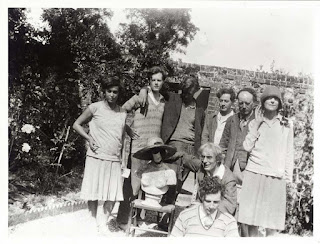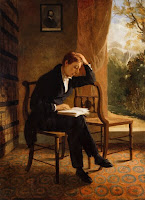The Sartorial Commodity Revisited
 |
| Members of the Bloomsbury group, Tate Museum Archives |
I have new eyes, of course, in the sense that I now understand what Koppen is talking about when she references the post-impressionist art galas Woolf attended with the rest of the Bloomsbury group. The Bloomsbury group, in a perfect full-circle moment, being the topic of my presentation for this class makes me laugh considering the novel itself involves unescapable themes of connectedness. Woolf, perhaps, had a point.
The Bloomsbury group was infamous for their radical social and political ideas that they often expressed through their art, specifically through paintings or works of writing. Koppen, however, suggests that these controversial ideologies bled through into their choice of clothing as well: "Woolf's (and Bloomsbury's) sartorial crossing of boundaries of 'civilised' and 'primitive', man and woman, English and Oriental, brings out similar reactions by enacting the shock of the new in the social domain" (25). She discusses how the group, and Woolf herself, used their clothing and costuming to open up these conversations about the dichotomies of gender, and sexuality, and culture by transgressing the boundaries that were seemingly concrete in English society at the time. While this upset outsiders, their so-called "oddities" were certainly ahead of their time.
Sex and sexuality are topics commonly associated with the Bloomsbury group, as it is well known that many members were involved in affairs with... many other members. Vanessa Bell, for example, was romantically involved with her husband Clive Bell, of course, but also with Roger Fry and Duncan Grant. Duncan Grant himself had many romantic relationships with other men, notably during a time when homosexuality was heavily stigmatized in England. So of course, with their personal lives transgressing boundaries such as these, they would choose to dress in such a way that challenges social norms as well. Koppen states that "through costume, performance and sartorial practice, the participants speak to each other about the past, about the present moment, and about the future, laughing at authority and pomposity, at unthinking adherence to institutions, conventions, social and sexual mores, at the euphemisms and hyperboles of the nineteenth century and those who were still clinging to them" (26-27).
And that was the beauty of the Bloomsbury group. As Koppen points out, they were not always necessarily making a statement to society as a whole, but simply expressing these ideas between one another and essentially creating their own inner culture wherein style and creativity can flow freely. The institution of Bloomsbury group provided the members with a place to be themselves and explore the inherent contradictions of traditional roles in English society with likeminded individuals.
 |
| Illustration of the complex relationships of the group, by Rory Midhani |
Koppen, R. S. Virginia Woolf, Fashion and Literary Modernity. Edinburgh University Press, 2011.


Comments
Post a Comment